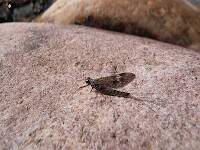
Blue-winged Olives
Baetis
Tiny Baetis mayflies are perhaps the most commonly encountered and imitated by anglers on all American trout streams due to their great abundance, widespread distribution, and trout-friendly emergence habits.
Featured on the forum

Some characteristics from the microscope images for the tentative species id: The postero-lateral projections are found only on segment 9, not segment 8. Based on the key in Jacobus et al. (2014), it appears to key to Neoleptophlebia adoptiva or Neoleptophlebia heteronea, same as this specimen with pretty different abdominal markings. However, distinguishing between those calls for comparing the lengths of the second and third segment of the labial palp, and this one (like the other one) only seems to have two segments. So I'm stuck on them both. It's likely that the fact that they're immature nymphs stymies identification in some important way.

Troutnut is a project started in 2003 by salmonid ecologist Jason "Troutnut" Neuswanger to help anglers and
fly tyers unabashedly embrace the entomological side of the sport. Learn more about Troutnut or
support the project for an enhanced experience here.
Troutnut on Jun 5, 2007June 5th, 2007, 8:08 am EDT
This question is mostly for Gonzo but I'm sure some other people would like to hear (or even offer) answers. In his book he has several patterns with poly yarn, foam, and similar synthetics which are fairly intricately colored, seemingly with markers. I've got the finest-tip craft markers I could find, but I still have major problems with the ink bleeding up and down the material (especially on poly yarn wings).
Anyone have any tips?
Anyone have any tips?
Jason Neuswanger, Ph.D.
Troutnut and salmonid ecologist
Troutnut and salmonid ecologist
Wiflyfisher on Jun 5, 2007June 5th, 2007, 11:52 am EDT
Jason one thing to note. Some synthetics are closed cells and some have open cells. A closed cell like polypropylene fibers will not accept a dye because it's dye sites are closed. Polypropylene fibers are used in indoor/outdoor carpets and you can pour bleach on them without loosing the color, because the dye sites are closed. It has to be dyed when in the liquid state before solidifying into those thin denier fibers.
Other synthetic fibers, such as nylon (Antron), have open dye sites and can be dyed topically. So depending on the type of synthetic material you are using you may have trouble getting the right results.
Other synthetic fibers, such as nylon (Antron), have open dye sites and can be dyed topically. So depending on the type of synthetic material you are using you may have trouble getting the right results.
John S.
https://WiFlyFisher.com
https://WiFlyFisher.com
Invicta on Jun 5, 2007June 5th, 2007, 12:01 pm EDT
Jason,
That’s a great question; I’ve had problems with synthetic coloration for years. As John S. pointed out, I have found the problem in using a marker to color synthetics occurs because there is not a convenient way to incorporate the marker color into the fiber structure of the synthetic. The marker will coat the outside of the synthetic fiber, but the molecules of the color pigment will not easily (if at all) lock onto, or into, the fibers. It’s not like dyeing feathers or fur, where you can lock the dye molecules into the natural fibers with a weak acid (vinegar). Some non aqueous markers are more persistent than others, but it has been my experience that with the right solvent (to include saliva) color movement will occur on smooth synthetic products. You may get a satisfactory color fastness in using material with extremely fine fibers, and working the color into the material so than any color bleeding occurs on the exposed outside fibers, while the inside coloration remains largely intact. On the other hand color migration may not occur easily in water with the materials you are using, so not to worry. One of the products I have used for holding the color in dyed materials is “Consort” men’s hair spray; you might try a light application of that product. It has a weak carrying agent so it doesn’t affect the ink color before the coating dries.
John
That’s a great question; I’ve had problems with synthetic coloration for years. As John S. pointed out, I have found the problem in using a marker to color synthetics occurs because there is not a convenient way to incorporate the marker color into the fiber structure of the synthetic. The marker will coat the outside of the synthetic fiber, but the molecules of the color pigment will not easily (if at all) lock onto, or into, the fibers. It’s not like dyeing feathers or fur, where you can lock the dye molecules into the natural fibers with a weak acid (vinegar). Some non aqueous markers are more persistent than others, but it has been my experience that with the right solvent (to include saliva) color movement will occur on smooth synthetic products. You may get a satisfactory color fastness in using material with extremely fine fibers, and working the color into the material so than any color bleeding occurs on the exposed outside fibers, while the inside coloration remains largely intact. On the other hand color migration may not occur easily in water with the materials you are using, so not to worry. One of the products I have used for holding the color in dyed materials is “Consort” men’s hair spray; you might try a light application of that product. It has a weak carrying agent so it doesn’t affect the ink color before the coating dries.
John
GONZO on Jun 5, 2007June 5th, 2007, 12:36 pm EDT
Jason,
John and John make some very good points, but I have to say that I've not experienced the bleeding problem you mention with poly yarn. "Permanent" marker color is often less than truly permanent on many synthetics, but the slight fading of color that occurs with time and use is easy to replenish should the fly survive long enough to need it. This is usually a surface coating of color rather than a dying of the fiber, but the color and markings are sufficently long-lasting to satisfy me.
That said, not all permanent marker colors are equal in their performance, even among the colors offered by a single manufacturer. Sharpie colors are usually strong and long-lasting, though the color selection is limited. Prismacolor and Pantone have some colors that work well and others that work less well. For the ultimate in fine markings, I've found that the Pigma Micron technical pens are superb--a choice of several very fine point sizes and very strong pigment--but only in black. What color/manufacturer were you using when you had the problem?
John and John make some very good points, but I have to say that I've not experienced the bleeding problem you mention with poly yarn. "Permanent" marker color is often less than truly permanent on many synthetics, but the slight fading of color that occurs with time and use is easy to replenish should the fly survive long enough to need it. This is usually a surface coating of color rather than a dying of the fiber, but the color and markings are sufficently long-lasting to satisfy me.
That said, not all permanent marker colors are equal in their performance, even among the colors offered by a single manufacturer. Sharpie colors are usually strong and long-lasting, though the color selection is limited. Prismacolor and Pantone have some colors that work well and others that work less well. For the ultimate in fine markings, I've found that the Pigma Micron technical pens are superb--a choice of several very fine point sizes and very strong pigment--but only in black. What color/manufacturer were you using when you had the problem?
Wiflyfisher on Jun 5, 2007June 5th, 2007, 4:10 pm EDT
Over the years I have had the advantage of being associated with the worlds largest fiber producers and I have several lifetimes supply of materials. The majority of what is used in fly tying is probably some sort of hybrid nylon synthetic that may also have been coated at the factory. (A true polypropylene fiber if you add any marker color it should wipe off with your finger.)
That said, Gonzo makes a good point that not all markers are the same. I personally don't use markers for fly tying anymore but I would bet some hold better than others.
That said, Gonzo makes a good point that not all markers are the same. I personally don't use markers for fly tying anymore but I would bet some hold better than others.
John S.
https://WiFlyFisher.com
https://WiFlyFisher.com
Quick Reply
Related Discussions
Topic
Replies
Last Reply
4
Apr 21, 2007
by PeterO
by PeterO
38
Feb 24, 2010
by Oldredbarn
by Oldredbarn
3
Jul 28, 2013
by Martinlf
by Martinlf






